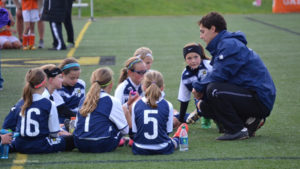Bruce: Five calls to action for youth soccer
By Skye Eddy Bruce, SoccerParenting.com
Editor’s note: Skye Eddy Bruce is the founder of The Institute for Soccer Parenting, a former All-American goalkeeper, professional player and collegiate coach. Skye holds her USSF “B” License and USSF National Goalkeeper License and is a parent and coach educator. She has coached at all levels of youth sports from Under-5 recreation to the U.S. national team programs and currently serves on the Executive Committee of the Richmond Strikers Soccer Club. She can be contacted via email ([email protected]) and her Twitter feed can be found here.
We must not measure the development of soccer in the United States simply by the number of people who play soccer, rather, we must measure it by the number of people who love soccer. It is the people who love soccer who will, over time, elevate soccer to the status of preeminent sport in the United States.
Our soccer leadership in organizations and clubs should be commended for their achievements in growing the game over the past 20 years as evidenced by our expanding professional men’s and women’s leagues, the rising number of soccer-specific stadiums, the growth of TV revenue, the cultivation of programming for U.S. youth national team programs and the staggering increase in the number of youth and adult players.
However, if our goals are to make soccer, in all its forms, the preeminent sport in the United States and to continue the development of soccer at all recreational and competitive levels, (the mission statement of U.S. Soccer), we still have far to go.
FIVE CALLS TO ACTION FOR YOUTH SOCCER
- WE MUST DO A BETTER JOB EDUCATING OUR YOUTH COACHES
Our paid youth coaches usually receive formal coaching education on the technical and tactical aspects of the game. However they often lack formal coaching education on player psychology, effective communication with players and parents, emotional intelligence training and the soft skills needed to make them most effective and qualified to work with children.
 We must add emotional intelligence training and communication training to our coaching education platforms to build a strong and unified soccer culture in the United States.
We must add emotional intelligence training and communication training to our coaching education platforms to build a strong and unified soccer culture in the United States.
At the recreation level, players are most-often coached by well-intentioned volunteer parents with no formal soccer coaching education. The untrained parent-coaches do not understand the Principles of Play and have little knowledge of how to best teach the very complicated game of soccer in the simplest way to our most impressionable players.
A coaching education course should be mandated of all coaches prior to them being allowed to work with players.
Our recreation program administrators say mandating education will not work because they already have trouble finding enough coaches.
+READ: ‘U.S. Soccer will have to get girls Development Academy perfect in order to improve on ECNL’
Could it be that we have challenges finding enough recreation level coaches because unwilling parent/coaches feel they are unqualified since they don’t have the necessary knowledge of the game?
If we mandated education for our recreation level coaches would these parents feel more qualified, be more enthusiastic and continue coaching longer than the typical season or two, thereby providing a larger base of available coaches?
If we mandated education for our recreation-level coaches, would our novice players receive better training, find more enjoyment and therefore stick with the sport longer and love the game more?
We must appropriately and adequately support our recreational-level coaches who are working with the vast majority of our players in the United States.
- WE MUST ESTABLISH A SYSTEM FOR THE PAYMENT OF SOLIDARITY AND TRAINING FEES TO YOUTH CLUBS FROM PROFESSIONAL CLUBS

Our youth soccer club programs are responsible for the development of every single soccer player in the country and, at this moment, the clubs’ primary sources of revenue are parents — in the form of player registration fees, tournament participation fees and camp registration fees.
While the payment of solidarity and training fees would not significantly change the landscape of youth soccer given the large number of clubs and the small number of professional players, the time has arrived for the fees to be initiated, even if done voluntarily.
+Not sure what Solidarity and Training Fees are? READ HERE
Solidarity and training compensation could provide a secondary, much needed, not-to-mention earned, source of revenue to clubs from professional teams that are directly benefiting from the hard work, dedication and support of the clubs and parents.
With more and more of our youth players being courted by overseas clubs and a viable professional league in the United States, we must find a legal and workable way to acknowledge and compensate the positive contributions the clubs are making in the development of players without harming the financial model of MLS.
- WE MUST DO A BETTER JOB EDUCATING PARENTS
 When we develop a generation of parents who understand the game, we will develop a generation of kids who love the game.
When we develop a generation of parents who understand the game, we will develop a generation of kids who love the game.
If parents understand soccer rules, basic tactics and the general teaching methodologies of the game more clearly, they will be empowered to appropriately assess the quality of their child’s coach. Parents must demand coaches they can trust who make decisions for their child based on their Long Term Athletic Development and their child’s athletic potential and mentality.
The positive role a parent can play in the soccer development of their child must be acknowledged, lauded and supported by clubs and coaches through the establishment of a more collaborative environment between clubs, coaches and parents.
- WE MUST ADVOCATE FOR YOUTH SOCCER, SO U.S. SOCCER FOCUSES ON DEVELOPING A NATIONAL LOVE OF THE GAME
Time and time again, U.S. Soccer has demonstrated through its decision-making process that it feels the best way to continue the development of soccer at all recreational and competitive levels is through focusing on the national team programs. They take a top-down approach, believing that if our national team is successful, our game will continue to develop.
 Of course, there is an undeniable correlation between the U.S. Men and U.S. Women winning and the development of the game.
Of course, there is an undeniable correlation between the U.S. Men and U.S. Women winning and the development of the game.
However, there is a more significant correlation between people loving the game and the development of the game.
If we want more people to love the game, U.S. Soccer must focus on building alliances with the millions of recreation and competitive-level players. It is this vast majority of “average” players who make up the foundation of the soccer culture of the United States.
U.S. Soccer must find a way to develop the extremely elite players who will make up our national team player pools, while simultaneously supporting these foundational players in the United States who will never play at a level demonstrative of a college player, let alone a national team or professional player. The more we grow and support the foundation, the better the top will become.
+READ: Jefferson Cup releases top brackets for 2016 (Girls)
U.S. Soccer must concentrate on establishing connections with the foundation players by reviewing their decision making processes that often seem unconnected to the foundation players such as their recent mandate to move to Birth-Year Registration for all players in the United States regardless of their level, and their even more short-sighted decision about how to implement the new Birth Year Registration mandate.
With this decision, U.S. Soccer has disenfranchised the millions of foundation players who play at an average level and are far more concerned with playing with friends than being identified for a national team program or playing against teams from foreign countries.
U.S. Soccer must build strong alliances with their foundation players as they develop a love for the game, not disenfranchise them with a top down approach to decision making.
- WE MUST CREATE A COMMON LANGUAGE AND A COMMON PATH FOR PLAYER DEVELOPMENT
Strides have been made to nationalize our soccer language with the adoption of the player numbering system and the revamping of the coaching education programs through U.S. Soccer. That being said, we still have a long way to go. Having a common soccer language is essential. Given our country’s size, maintaining a common soccer language is extremely difficult.
 Different clubs offer youth training programs with different names, the result being a confusing environment for parents across the country. There is no way for a soccer parent in California to talk to a friend who is also a soccer parent in Virginia and discuss the soccer experience of their respective children using a common language.
Different clubs offer youth training programs with different names, the result being a confusing environment for parents across the country. There is no way for a soccer parent in California to talk to a friend who is also a soccer parent in Virginia and discuss the soccer experience of their respective children using a common language.
Even in writing this it is not clear what is referred to when “competitive” soccer is discussed. In various parts of the country it is referred to as “Elite” – “Select” – “Travel,” or other names.
+DURE: NSCAA Convention shows soccer still needs to work on sales pitch
How practical it would be if our novice players, for instance, moved from Level 1 to Level 2 to Level 3 based on their mentality and athletic potential (and the choice of their parents about how to best spend their time) between the ages of 5 and 10 – and then had additional programming available to them between ages 11 and 13 of Level 4 and Level 5 and Level 6. Then the player could progress – if they wanted to and if they had the athletic potential and mentality – to Level 7, Level 8 and Level 9 for ages 14-17. If the area or club is a small one, all the programming levels may not be available, but it would still be clear where the children fell along the developmental pathway.
The names of the levels are not significant to this discussion, as long as they are the same across the country. This is simply a call to action for uniformity in programming across our vast country.
We must continue to work to create a common language and a common pathway for soccer development.
When children play at appropriate levels based on their athletic potential and mentality – with qualified coaches who care about their development as people and athletes, on teams and clubs who have clearly defined objectives based on their competition level, and with parents who support and encourage them along their soccer journey – we will be developing a generation of soccer players who love the game.
While we can and should celebrate how far we have come in the past 20 years, we must always continue to keep our eyes on the future of the game. We must measure our success in establishing soccer as a preeminent sport by developing a generation of players who don’t just play soccer, rather a generation of players who love soccer.
SOCCERWIRE MARKETPLACE
- Girls College ID Soccer Camp – Showcase Your Skills!
- Real Colorado Cup 2026
- Join a College Coaches Showcase Camp Today
- MICFootball Punta Cana 2026
- Dana Cup Hjørring 2026
- 15th Annual Loudoun Soccer College Showcase
- OFFICIAL FC BARCELONA SOCCER CAMPS - PROMO CODE: FCBSOCCERWIRE
- New England Copa Surf 2026
- Adidas National Cup 2026
- visitRaleigh.com Showcase Series 2025, hosted by NCFC Youth











